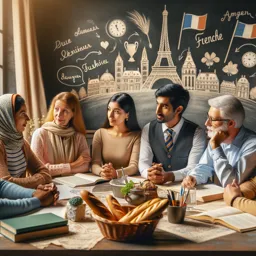At the B1 level in French, being able to give detailed descriptions of people, places, and objects is essential for effective communication. This guide will help you expand your vocabulary and improve your sentence structures, allowing you to describe things in more depth and with greater precision.
1. Describing Physical Appearance
When describing people’s physical appearance, you can add more details by using a combination of adjectives and specific vocabulary:
- Il a les cheveux courts et bruns. (He has short, brown hair.)
- Elle porte des lunettes et a les yeux bleus. (She wears glasses and has blue eyes.)
Key adjectives:
- Chauve (bald)
- Frisé(e) (curly)
- Mince (slim)
- Costaud (muscular)
Use avoir (to have) for hair and eye descriptions and être (to be) for overall appearance.
2. Describing Personality
To give detailed descriptions of personality, use adjectives that reflect the individual’s character traits:
- Il est généreux, mais parfois un peu têtu. (He is generous, but sometimes a bit stubborn.)
- Elle est très sociable et drôle. (She is very sociable and funny.)
Common personality adjectives:
- Gentil(le) (kind)
- Amical(e) (friendly)
- Diligent(e) (hardworking)
- Réservé(e) (reserved)
3. Describing Places: Towns and Cities
When describing towns or cities, use a mix of adjectives to convey the atmosphere, size, and landmarks:
- C’est une ville historique avec de nombreux monuments. (It’s a historic city with many monuments.)
- La ville est moderne et très animée. (The city is modern and very lively.)
Key vocabulary:
- Spacieux/spacieuse (spacious)
- Sombre (dark)
- Charmant(e) (charming)
- Pittoresque (picturesque)
For towns and cities, use phrases like il y a (there is/are) to introduce landmarks or specific features.
4. Describing Nature and Landscapes
When describing landscapes or natural surroundings, focus on geographical features and the environment:
- Le paysage est magnifique avec des montagnes enneigées. (The landscape is beautiful with snow-capped mountains.)
- La plage est entourée de palmiers. (The beach is surrounded by palm trees.)
Key terms:
- Le désert (desert)
- La vallée (valley)
- La colline (hill)
- Le rivage (shore)
Use prepositions such as autour de (around) and près de (near) to specify location and proximity.
5. Using Comparisons in Descriptions
Comparisons are useful for giving more detailed descriptions. Use plus… que (more… than), moins… que (less… than), and aussi… que (as… as):
- Cette maison est plus grande que la nôtre. (This house is bigger than ours.)
- Le village est moins animé que la ville. (The village is less lively than the city.)
Comparisons help to make your descriptions more precise and nuanced.
6. Describing Emotions and Feelings
At the B1 level, you can also describe how people feel, both physically and emotionally:
- Je me sens fatigué aujourd’hui. (I feel tired today.)
- Il semble nerveux à cause de l’examen. (He seems nervous because of the exam.)
Key adjectives for emotions:
- Inquiet/inquiète (worried)
- Enthousiaste (enthusiastic)
- Détendu(e) (relaxed)
- Mécontent(e) (unhappy)
Adding details about how someone feels allows for more in-depth conversations and descriptions.
7. Sentence Structures for Descriptions
To give detailed descriptions, use relative pronouns such as qui (who/which), que (that), and dont (whose):
- La maison qui est sur la colline est magnifique. (The house that is on the hill is beautiful.)
- C’est une ville dont j’ai entendu parler. (It’s a city that I’ve heard of.)
These structures allow you to link ideas together and create more complex sentences.
Conclusion
Giving detailed descriptions in French at the B1 level is a valuable skill that helps you communicate more effectively. By expanding your vocabulary, mastering comparative structures, and using appropriate adjectives, you’ll be able to describe people, places, and emotions with clarity and precision. Keep practicing to enhance your fluency!

































